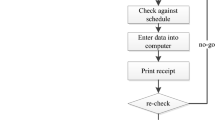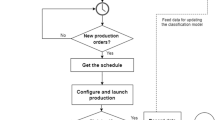Abstract
The present work is meant to show the effective capability of optimizing an unbalanced Paired-Cell Overlapping Loops of Cards with Authorization (POLCA)-controlled production system by means of a heuristic algorithm. This objective is suggested by the fact that one of the most significant issues when using card-driven production control systems is represented by the optimized setting of the large number of cards within the control loops. This is particularly true in the case of unbalanced systems, where the number of cards may vary significantly among the different loops. Little law is usually adopted in literature to infer this number from historical data, but the obtained number is usually far from the optimum. Indeed, in real-world applications, the systems to be controlled are designed to process units with very different routings, each with different probability to occur. In all these situations, they result particularly difficult to set correctly. To this aim, in the present work a Genetic Algorithm is used. The objective is that of finding the correct number of cards and to reduce the overall Total Throughput Time and the average Work In Process. The proposed approach may provide a valid support tool to overcome these limitations, making the most of POLCA capabilities in many manufacturing configurations.
Similar content being viewed by others
References
Suri R (1998) Quick Response manufacturing: a companywide approach to reducing leadtimes. Productivity Press, Portland
Germs R, Riezebos J (2010) Workload balancing capability of pull systems in MTO production. Int J Prod Res 48(8):2345–2360
Koulouriotis DE, Xanthopoulos AS, Tourassis VD (2010) Simulation optimization of pull control policies for serial manufacturing lines and assembly manufacturing systems using genetic algorithms. Int J Prod Res 48(10):2887–2912
Gstettner S, Kuhn H (1996) Analysis of production control systems Kanban and CONWIP. Int J Prod Res 34(11):3253–3273
Selvaraj, N. (2009) Determining the number of Kanbans in EKCS: a simulation modeling approach. Proceedings of the International Multi-Conference of Engineers and Computer Scientists IMECS, Vol. II, Hong Kong
Alabas C, Altiparmak F, Dengiz B (2000) The optimization of number of kanbans with genetic algorithms, simulated annealing and tabu search. Congress on Evolutionary Computation (CEC2000), July 16–19, 2000, San Diego, USA, 580–585
Köchel P, Nieländer U (2002) Kanban optimization by simulation and evolution. Prod Plan Control 13(8):725–734
Hu S, Yi W (2009) Simulation and optimization of kanban system for steel rolling. International Workshop on Intelligent Systems and Applications, ISA 2009, 1–4
Al-Tahat M, Liverani A, Persiani F, Caligiana G (2002) Using genetic algorithms to optimize kanban-based production system. The European Applied Business Research Conference, Rothenburg
Huang M, Wang D, Ip WH (1998) A simulation and comparative study of the CONWIP, Kanban and MRP production control systems in a cold rolling plant. Prod Plan Control 9(8):803–812
Hopp WJ, Roof ML (1998) Setting WIP levels with statistical throughput control in CONWIP production lines. Int J Prod Res 36(4):867–882
Herer YT, Masin M (1997) Mathematical programming formulation of CONWIP-based production lines and relationships to MRP. Int J Prod Res 35(4):1067–1076
Golany B, Dar-El EM (1999) Controlling shop floor operations in a multi-family, multi-cell manufacturing environment through constant WIP. IIE Trans 31(8):771–781
Ajorlou, S., Shams, I., Aryanezhad, M.G. (2011) Optimization of a multiproduct CONWIP-based manufacturing system using artificial bee colony approach. Proceedings of the International Multi-Conference of Engineers and Computer Scientists IMECS, Vol. II, Hong Kong
Riezebos, J. (2009) Design of POLCA material control systems. Proceedings of the International Conference on Intelligent Manufacturing & Logistics Systems IML2009, Waseda University, Kitakyushu, Japan
Goldberg DE (1989) Genetic algorithms in search, optimization, and machine learning. Addison-Wesley Professional, Upper Saddle River, Reading
Aytug H, Khouja M, Vergara FE (2003) Use of genetic algorithms to solve production and operations management problems: a review. Int J Prod Res 41(17):3955–4009
Dostál P (2013) The use of soft computing for optimization in business, economics, and finance. Meta-Heuristics Optimization Algorithms in Engineering, Business, Economics, and Finance, 41–86
Senvar O, Turanoglu E, Kahraman C (2013) Usage of metaheuristics in engineering: a literature review. Meta-Heuristics Optimization Algorithms in Engineering, Business, Economics, and Finance, 484–528
Reeves CR (1994) Genetic algorithms and neighborhood search. Evol Comput Lect Notes Comput Sci 865:115–130
Rudolph G (1994) Convergence analysis of canonical genetic algorithms. IEEE Trans Neural Netw 5:96–101
Aytug H, Koehler GJ (2000) New stopping criterion for genetic algorithms. Eur J Oper Res 126:662–674
Author information
Authors and Affiliations
Corresponding author
Rights and permissions
About this article
Cite this article
Braglia, M., Castellano, D. & Frosolini, M. Optimization of POLCA-controlled production systems with a simulation-driven genetic algorithm. Int J Adv Manuf Technol 70, 385–395 (2014). https://doi.org/10.1007/s00170-013-5282-5
Received:
Accepted:
Published:
Issue Date:
DOI: https://doi.org/10.1007/s00170-013-5282-5




